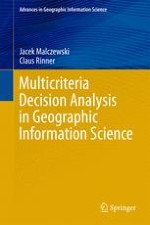2015 | OriginalPaper | Chapter
8. GIS-MCDA for Group Decision Making
Authors : Jacek Malczewski, Claus Rinner
Published in: Multicriteria Decision Analysis in Geographic Information Science
Publisher: Springer Berlin Heidelberg
Activate our intelligent search to find suitable subject content or patents.
Select sections of text to find matching patents with Artificial Intelligence. powered by
Select sections of text to find additional relevant content using AI-assisted search. powered by
